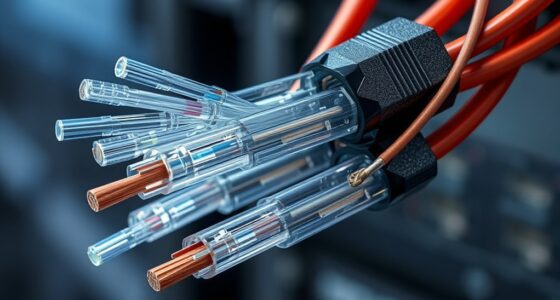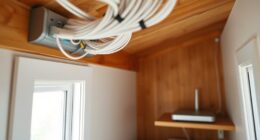Did you know that organizations with well-organized cable management see up to 30% faster troubleshooting times? Using patch panels can substantially streamline your network setup, making maintenance and upgrades easier. They provide a central point to connect and disconnect cables efficiently, reducing clutter and minimizing potential errors. Considering the long-term benefits, it’s worth exploring how patch panels can enhance your network’s reliability and scalability.
Key Takeaways
- Centralizes connections, reducing cable clutter and simplifying management.
- Eases troubleshooting and upgrades by providing clear access points.
- Enhances network reliability through organized and properly terminated cables.
- Supports scalability and flexible reconfiguration for future growth.
- Improves overall network efficiency, reducing downtime and maintenance costs.

Are patch panels worth the investment? If you’re looking to improve your network setup, the answer is a definite yes. Patch panels play a critical role in cable management and network organization, making your infrastructure more efficient and easier to maintain. By centralizing your connections, they eliminate the chaos of tangled wires and scattered cables, giving you a clear overview of your entire network. This improved cable management not only looks neater but also reduces the risk of accidental disconnections or damage caused by pulling or bending cables. When your cables are properly organized, troubleshooting becomes faster, and future upgrades are simpler to implement because you can easily identify and access specific connections.
Using patch panels allows you to streamline your network setup, especially as it grows. Instead of running individual cables directly into switches or servers, you connect everything through the patch panel. This setup creates a single point where all your cables converge, making it easier to manage changes or additions without disrupting the entire network. When you need to add or replace hardware, patch panels let you do so quickly without disturbing existing connections. This flexibility saves time and reduces downtime, which is essential for maintaining productivity, especially in business environments.
Another advantage is that patch panels enhance the overall reliability of your network. When cables are neatly organized and properly terminated on a patch panel, there’s less chance of loose connections or signal interference. This stability ensures your network performs at its best and minimizes failures. Additionally, by keeping cables tidy, you avoid accidental disconnections that might happen when cables are intertwined or hidden behind furniture or equipment. This level of organization makes it easier to identify issues quickly, enabling you to troubleshoot and resolve problems faster. Being aware of narcissistic behaviors and gaslighting tactics can also help in managing network issues that require clear documentation and communication.
Investing in a patch panel also future-proofs your network. As your needs evolve, you’ll find it much easier to reconfigure or expand your setup. Instead of dealing with a spaghetti mess of cables, you can simply move patch cords around on the panel. This adaptability is essential when you’re planning for growth or implementing new technology. Plus, with clear labeling on patch panels, you can easily document your connections, ensuring everyone involved understands the network layout and can maintain or troubleshoot it efficiently.
In the end, patch panels are a smart investment that pays off by improving cable management, boosting network organization, and making your entire setup more reliable and scalable. They might seem like a small component, but their impact on your network’s efficiency and ease of maintenance is substantial.
Frequently Asked Questions
How Do Patch Panels Impact Network Scalability?
Patch panels considerably impact your network scalability by simplifying network expansion and enhancing cable management. When you add new devices, patch panels make it easy to connect or reconfigure cables without disrupting existing setups. They organize your cables neatly, reducing clutter and making future upgrades smoother. As your network grows, patch panels save you time and effort, ensuring your infrastructure remains flexible, efficient, and ready to accommodate increased demands.
Are Patch Panels Compatible With All Cable Types?
Yes, patch panels are compatible with most cable types, but you should check cable compatibility and material durability to guarantee ideal performance. Patch panels work well with Ethernet cables like Cat5e, Cat6, and Cat6a. They also support fiber optic cables with the right adapters. Choose patch panels made from durable materials to prevent damage and maintain reliable connections over time. Always verify compatibility before installation for the best results.
What Is the Typical Lifespan of a Patch Panel?
Think of your patch panel like a trusty smartphone—it can last around 10 to 15 years with proper care. During durability testing, engineers check its material composition to make certain it withstands wear and tear. Regular inspections and maintenance help extend its lifespan. Keep in mind, environmental factors like temperature and humidity also influence longevity, so choose a high-quality panel built for durability to get the most out of your investment.
How Do Patch Panels Affect Network Troubleshooting?
Patch panels simplify network troubleshooting by organizing cables and enhancing cable management, making it easier to identify and isolate issues quickly. They help maintain signal integrity by preventing cable clutter and ensuring proper connections. With clear labeling and a structured setup, you can troubleshoot problems more efficiently, saving time and reducing errors. Overall, patch panels streamline network maintenance, keeping your system reliable and easier to manage during troubleshooting efforts.
Can Patch Panels Be Used in Outdoor Environments?
Yes, patch panels can be used outdoors, but you need to consider weather resistance. Choose a patch panel specifically designed for outdoor environments that can withstand moisture, temperature fluctuations, and UV exposure. During installation, ensure proper sealing and protection from the elements. Proper installation considerations include using weatherproof enclosures and grounding to prevent damage and maintain reliable network performance in outdoor settings.
Conclusion
Incorporating patch panels promotes perfect performance and pristine organization, transforming tangled cables into tidy tapestries. They simplify troubleshooting, save time, and support seamless scalability, shielding your network from chaos. With a clear, centralized connection point, you’ll enjoy consistent signal strength and reduced interference. Embrace the benefits of patch panels to foster a flexible, fuss-free future, and keep your network neat, nimble, and never in a knot.









